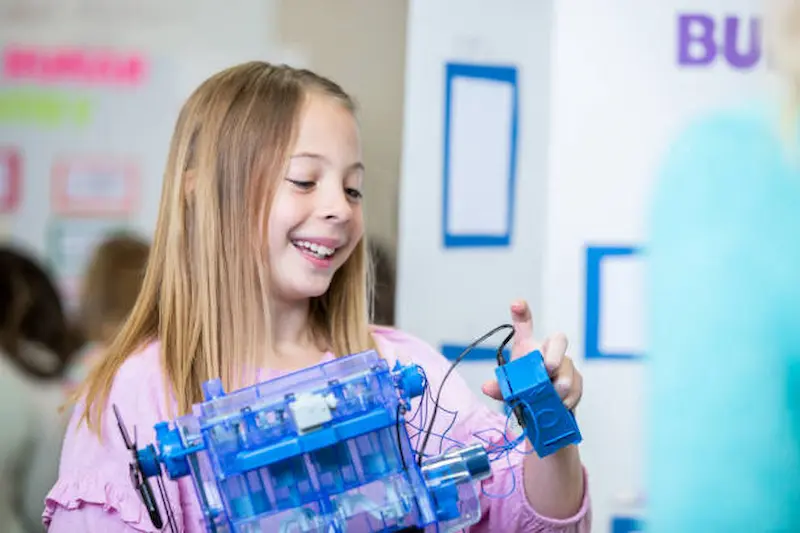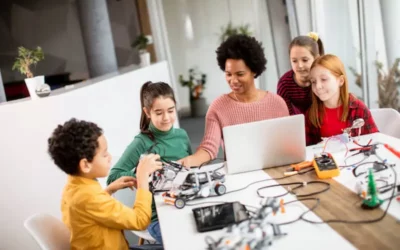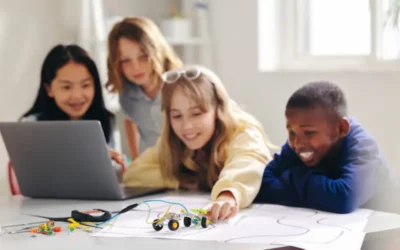A robot is a programmable, autonomous or semi-autonomous machine designed to perform tasks and interact with its environment. They come in various forms, from industrial arms to autonomous drones and humanoid robots. Robots have a growing presence in our daily lives, revolutionizing industries like manufacturing, healthcare, and logistics. They also serve in hazardous environments and space exploration, enhancing safety and efficiency. Understanding robot components is essential for harnessing their potential and making informed decisions about their applications.
In this blog, we delve into the fascinating world of robotics by exploring the essential components of every robot, shedding light on the core elements that bring these mechanical marvels to life.
Table of contents
The Power Source

The power source is a critical component in robotics, directly influencing a robot’s performance and capabilities. There are various types of power sources employed in robotics:
A. Types of Power Sources:
- Batteries:
Batteries are common in mobile robots, offering portability and ease of use. They come in various types, such as lithium-ion and nickel-metal hydride, each with its own advantages and limitations.
- Fuel Cells:
Fuel cells are gaining popularity for their extended runtime and clean energy profile. Hydrogen fuel cells, in particular, are used in some robotic applications.
- Solar Panels:
Solar-powered robots harness energy from sunlight, making them sustainable and suitable for outdoor tasks like agriculture and environmental monitoring.
B. Energy Efficiency in Robots:
Energy efficiency is a crucial consideration in robot design. Efficient power management and low-power components can extend a robot’s operational time and reduce environmental impact. Advances in energy-efficient motors, sensors, and control systems, including online robotics for kids, are continually improving a robot’s ability to perform tasks effectively while conserving power. As robotics continues to advance, optimizing energy usage will play a pivotal role in the development of more capable and environmentally friendly robots.
Actuators and Motors

Actuators and motors play a pivotal role in a wide range of mechanical systems, powering movements and enabling automation. Understanding these components is crucial for engineers and technologists.
A. Understanding Actuators
- Electric Motors: Electric motors are devices that convert electrical energy into mechanical motion. These are common, converting electrical energy into mechanical motion. They’re versatile, used in appliances, vehicles, and industrial machinery.
- Hydraulic Actuators: Hydraulic actuators utilize pressurized fluid to generate high-force and precise motion. Using pressurized fluid, these actuators provide high force and precise control, often used in heavy machinery and construction equipment.
- Pneumatic Actuators: Pneumatic actuators use compressed air to create motion, valued for their lightweight yet powerful characteristics, commonly used in robotics, automation, and aerospace. Air-powered actuators are lighter but still powerful, employed in robotics, automation, and aerospace.
B. Motor Types and Their Functions
- Servo Motors: Servo motors are specialized motors designed for precise control, frequently used in robotics, CNC machines, and camera stabilization systems. Ideal for precise control, they’re used in robotics, CNC machines, and camera stabilization systems.
- Stepper Motors: Stepper motors provide accurate, step-by-step movement, essential in applications like 3D printing and automation systems. Known for their accuracy and step-by-step movement, they’re vital in 3D printing and automation systems.
- DC Motors: DC motors are straightforward and reliable devices converting electrical energy into rotational motion, commonly found in small appliances, electric vehicles, and power tools.
.
Sensors
A. Sensor Types
- Vision Sensors: Vision sensors, like cameras and depth sensors, provide robots with visual perception. They enable object recognition, navigation, and even complex tasks like reading barcodes or identifying defects in manufacturing.
- Proximity Sensors: Proximity sensors detect the presence or absence of objects in their vicinity. They’re crucial for collision avoidance, object tracking, and ensuring safe robot operation in dynamic environments.
- Tactile Sensors: Tactile sensors mimic the human sense of touch. They allow robots to feel and respond to physical contact, making them valuable for delicate tasks like picking up fragile items or performing surgery.
B. The Role of Sensors in Robot Perception
Sensors are the sensory organs of robots, providing vital information about their surroundings. They form the foundation of robot perception, enabling them to interact with the world intelligently, adapt to changing conditions, and perform tasks with precision and safety.
Control Systems

The control system is the brain of a robot, responsible for orchestrating its movements and actions. Here’s a breakdown of key components:
A. Central Processing Unit (CPU):
The CPU serves as the robot’s core processor, handling tasks like decision-making, data processing, and interfacing with sensors and actuators. It executes algorithms that enable the robot to navigate, perceive its environment, and perform assigned functions.
B. Microcontrollers and Their Functions:
Microcontrollers are specialized chips within robots, managing specific tasks like motor control, sensor data processing, and communication with external devices. They facilitate real-time control, making them vital for robot responsiveness and accuracy.
C. Programming Languages for Robots:
Various programming languages, such as Python, C++, and ROS (Robot Operating System), are used to code robots. The choice of language depends on the robot’s purpose and complexity. Python, for example, is popular for its simplicity and versatility, including Python for kids, making it an excellent choice for those new to programming and robotics. C++ offers performance advantages for more complex robotics applications. ROS, on the other hand, is a comprehensive framework that streamlines robot development, fostering collaboration and reusability in the robotics community.
Manipulators and End-Effectors
Manipulators and End-Effectors are fundamental components in robotics and automation. Manipulators are robotic arms that perform tasks with precision and dexterity, such as assembly or welding. End-effectors, often attached to manipulators, are specialized tools or grippers designed for specific tasks, like picking and placing objects. These systems are crucial in manufacturing, healthcare, and space exploration, streamlining processes and increasing efficiency while reducing the need for human intervention in hazardous or repetitive tasks.
In addition to traditional education, the availability of online robotics for kids has further expanded the reach of these concepts to the younger generation, allowing them to explore and learn about these exciting fields in a digital and interactive environment.
Communication Systems

Communication Systems play a pivotal role in our connected world, encompassing several key aspects:
A. Wired vs. Wireless Communication:
The choice between wired and wireless communication hinges on specific needs. Wired connections offer unparalleled stability and security, making them ideal for critical applications like financial transactions and medical devices. On the other hand, wireless communication provides the freedom of mobility and convenience, making it better suited for remote connectivity, mobile devices, and the vast Internet of Things (IoT) ecosystem.
B. Human-Robot Interaction and Communication:
As robots become increasingly integrated into our daily lives, the field of human-robot interaction (HRI) and communication is gaining prominence. Developing natural language processing (NLP) algorithms, gesture recognition systems, and selecting the best robotics for kids enhances the ability of robots to understand and respond to human commands and cues.
This is crucial for collaborative tasks in industries like manufacturing and healthcare, as well as for service robots that assist with household chores or customer service. HRI research aims to make human-robot communication as seamless and intuitive as possible, enabling robots to work alongside humans effectively and safely. Integrating the best robotics for kids also helps in introducing younger generations to the world of technology and robotics in a fun and educational way, fostering early interest and skill development in these fields.
Safety Features
In the realm of robotics, safety is of paramount importance to protect both humans and machines. Here are key considerations:
A. Ensuring Robot Safety:
- Emergency Stop Buttons: These critical devices allow immediate cessation of robot operation in case of emergencies or unexpected behavior, reducing the risk of accidents and injuries.
- Collision Avoidance Systems: Equipping robots with sensors and algorithms for collision avoidance prevents accidental collisions with objects, obstacles, or humans, enhancing safety in dynamic environments.
B. Safety Regulations and Standards:
Compliance with safety regulations and standards, as well as implementing child safety tips, is essential in the development and deployment of robots. Organizations like ISO and ANSI have established guidelines to ensure the safe use of robots in various industries, promoting consistency and best practices. Adherence to these regulations not only safeguards human lives, including those of children, but also fosters confidence in the integration of robots into our daily lives.
Implementing child safety tips further ensures that the presence of robots does not pose any risks to the well-being of children, allowing for their safe interaction with this advancing technology.
Maintenance and Repairs

Maintenance and repairs are essential for ensuring the longevity of systems, much like how engaging activities are crucial for a child’s growth and development. Regular maintenance helps prevent unexpected breakdowns, reduces downtime, and minimizes costs. Skilled technicians play a key role in identifying and resolving issues quickly, ensuring smooth operations and extending the lifespan of equipment. Similarly, enrolling children in robotics classes for kids provides them with engaging and educational activities that keep them active, curious, and intellectually stimulated, contributing to their overall growth and well-being.
Conclusion
Robots are automated machines capable of performing tasks with precision and consistency, ranging from industrial manufacturing to healthcare and exploration. They enhance efficiency and precision in manufacturing, reduce human exposure to hazardous environments, and assist in healthcare through surgeries and patient care. Moreover, robots are increasingly used in education to stimulate creativity and problem-solving skills in students. Their versatility and adaptability continue to drive innovation and improve our quality of life.
To get your hands on more educational and free resources on coding for kids, robotics for kids, financial education for kids, etc., do check out the BrightCHAMPS Page now!
To get your hands on more such educational and free resources on coding, robotics, game development, etc., do check out the Brightchamps Blog Page now!
Frequently Asked Questions ( FAQs )
A1. The primary purpose of a robot’s power source is to provide the energy required for its operation, enabling movement, processing data, and executing tasks.
Q2. How do actuators enable robot movement?
A2. Actuators enable robot movement by converting electrical or mechanical signals into physical motion, controlling the robot’s limbs, wheels, or other parts.
Q3. What are some common sensors used in robotics?
A3. Common sensors used in robotics include cameras, ultrasonic sensors, infrared sensors, and touch sensors, allowing robots to perceive and interact with their environment.
Q4. How does a robot’s control system work?
A4. A robot’s control system works by processing input from sensors, interpreting it through programmed algorithms, and generating output commands to actuate motors or other components, enabling the robot to perform tasks.
Q5. What is the significance of manipulators in industrial robots?
A5. Manipulators in industrial robots are significant as they are responsible for precise and controlled movements, essential for tasks like welding, assembly, and material handling in manufacturing processes.


 We are an army of educators and passionate learners from BrightChamps family, committed to providing free learning resources to kids, parents & students.
We are an army of educators and passionate learners from BrightChamps family, committed to providing free learning resources to kids, parents & students.













